

 youtube.com/v/rDs0fOVj090
youtube.com/v/rDs0fOVj090


 youtube.com/v/rDs0fOVj090
youtube.com/v/rDs0fOVj090

BRITISH RIFLE-BAYONET CHARGE IN IRAQ: 2006
 youtube.com/watch?v=c2tZzTwDL_E
youtube.com/watch?v=c2tZzTwDL_E
Excursion to Hell: Mount Longdon: An Universal Story of Battle
FALKLANDS: June 12, 1982
3-Para mounts an assault on Mount Longdon. The battle on this heavily defended position, which was supposed to last until dawn, proves much tougher and longer than expected. Mount Longdon and its surroundings are finally taken after hand-to-hand and bayonet fighting with the Argentine troops position by position. The British casualties mount to 23 men, one of which, Sergeant Ian John McKay of 3-Para is later awarded a posthumous Victoria Cross, 47 more British are wounded. The Argentine suffer over 50 dead and many more injured. 6 more British die shortly afterwards.
RIFLE-BAYONET AS A BATTLE WEAPON

Its very humorous to constantly hear from mainstream America--and even Soldiers in the Army--how certain things have become "passee" or obsolete in their small minds. They say "horse cavalry" is dead, yets its alive and well in Afghanistan. That battleships are "a thing of the past"; yet our 4 x Iowa class battleships are the most missile armed and protected ships in the world--even though we have them in mothballs because they threaten the aircraft carrier racket bureaucrats.
Bayonets for the Personal Assault Zone (PAZ) Fight

One of the common misconceptions about infantry combat is that the "bayonet charge is obsolete".
This comes from the mistaken notion that since the military bureaucracy (MILB) mistakenly does not currently employ bayonets as high-visibility organized aspects of an attack that they are not even needed as individual capabilities. The American MILB is both corrupt and incompetent--don't trust it to accomplish the mission or to protect the lives of your men. "Supply System" is a joke--an oxymoron like "military intelligence"--a contradiction of terms in a bureaucracy of petty tyrants bent on doing as little as possible at maximum taxpayer costs. You are going to run out of ammunition and not have all that you need to win in the MILB. Moreover, the bayonet was necessary during the early years of firearms because it was slow to reload muzzle loading weapons. The time could come when you were too close to the enemy to stop and ram down a charge and patch then ball, since he could just stab you with a knife at this point. So we fixed knives to the end of our shoulder weapons so when we got close we could engage in hand-to-hand combat until such time we were seperated far enough to reload safely. In fact, our nation owes its very existence as a unified whole thanks to Col Joshua Lawrence Chamberlain's desperate bayonet charge ("Fix Bayonets, Charge!...Fix Bayonets, Charge!")on Little Round Top Hill when his men ran out of ammunition, but saved the Union army's left flank with their audacity. Watching the film "Gettysburg" would be a good "training event" to drive home the technical reasons for the early rifle-bayonet interface, a close range weapon when reloading or in close. A bayonet charge by LTC Harold G. Cole's 101st Airborne Division "Screaming Eagles" took the town of Carentan joining the two D-Day beach forces together and earned him a Congressional Medal of Honor. Or then Captain Lewis Millett's bayonet charge in the Korean war, which earned him a CMH...

MILLETT, LEWIS L.Rank and organization: Captain, U.S. Army, Company E, 27th Infantry Regiment. Place and date: Vicinity of Soam-Ni, Korea, 7 February 1951. Entered service at: Mechanic Falls, Maine. Born: 15 December 1920, Mechanic Falls, Maine. G.O. No.: 69, 2 August 1951.
Citation:
Capt. Millett, Company E, distinguished himself by conspicuous gallantry and intrepidity above and beyond the call of duty in action. While personally leading his company in an attack against a strongly held position he noted that the 1st Platoon was pinned down by small-arms, automatic, and antitank fire. Capt. Millett ordered the 3rd Platoon forward, placed himself at the head of the 2 platoons, and, with fixed bayonet, led the assault up the fire-swept hill. In the fierce charge Capt. Millett bayoneted 2 enemy soldiers and boldly continued on, throwing grenades, clubbing and bayoneting the enemy, while urging his men forward by shouting encouragement. Despite vicious opposing fire, the whirlwind hand-to-hand assault carried to the crest of the hill. His dauntless leadership and personal courage so inspired his men that they stormed into the hostile position and used their bayonets with such lethal effect that the enemy fled in wild disorder. During this fierce onslaught Capt. Millett was wounded by grenade fragments but refused evacuation until the objective was taken and firmly secured. The superb leadership, conspicuous courage, and consummate devotion to duty demonstrated by Capt. Millett were directly responsible for the successful accomplishment of a hazardous mission and reflect the highest credit on himself and the heroic traditions of the military service.
Everywhere infantry combat takes place, the bayonet gets used--we just don't want to admit it in our infatuation with electro-gizmos.
Actually, this reality is still true today.
While we have made loading instantaneous with self-contained cartridges held in detachable magazines, it still takes a few critical seconds to remove the magazine and put a new one inside. If you are close to the enemy, he could stab or shoot to kill you before you are reloaded. Even more so, to shoot accurately you need to aim, and in hand-to-hand combat the scuffling will not allow you to aim and hit the enemy.
Thus, bayonets are still standard equipment on most infantry weapons AND recent combat operations PROVE that the ability to bayonet charge is still important.
Take a look at these bayonets used by the Russian Airborne:

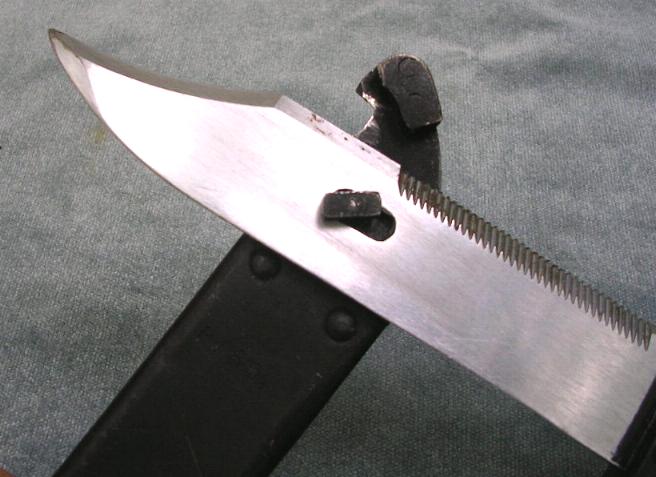

 www.youtube.com/watch?v=pbtujMKcVOA
www.youtube.com/watch?v=pbtujMKcVOA


U.S. Army "Sky Soldier" fighting fear, fatique and the North Vietnames Army with the M16 assault rifle and M7 bayonet at Landing Zone X-Ray in the Vietnam War, described in the Pulitzer-prize winning book, We were Soldiers Once and Young by LTG Hal Moore and Joe Galloway. LT Rick Rescorla pictured above lead his men by small arms fire and fixed bayonets over hardened NVA troops in 1965.
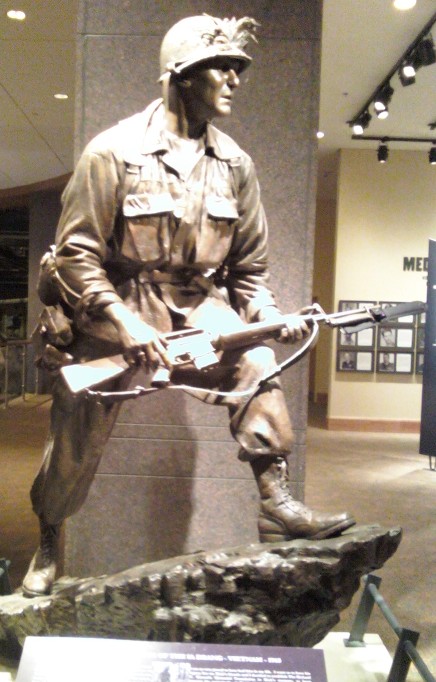
Erik Pakieser writes in:
I really enjoy reading your website. I periodically check it to keep myself
sharp. I served in the U.S. Army from 1988-1992 (serving in both Panama and
Gulf War I), and the Nasty Guard from 1992-1999, until medical issues forced
me out. What you are saying now is what I've been thinking all along - we
need a military that's designed to fight and win wars, not elections.
I did want to offer some 'supplemental' information for you - on your
Bayonet page you mentioned a Lt. in Vietnam who led bayonet charges at LZ
X-Ray. That Lt. would be Rick Rescorla. You might know it by now, but the
'Sky Soldier' pictured on the your bayonet page is Rick.
Rick Rescorla's story doesn't end in Vietnam. He was killed in the Sept. 11th terrorist attacks on the World Trade Center.
Here's a good link to Rick Rescorla's story:
http://militaryhistory.about.com/library/prm/blrickrescorla1.htm
Every time I read about Rick Rescorla, it reminds me of why I became a
Soldier.
Keep up the good work."
"Hello.
--LTC (Retired, USA) David Grossman, On Killing
Military veteran, historian and tactical innovator Emery Nelson writes:
"I've always felt that nothing could scare me more then being on the receiving end of a bayonet charge. I admit that I've read about them my whole life and this could have a lot to do with it. I remember reading, 'Hell In A Very Small Place' and seeing that every counter attack in which the French fixed bayonets, carried the day. I could almost feel the French losing confidence and using it less and less. Although it doesn't always work it will carry the day in most close situations. I don't remember his name but there was a Plt leader in We Were Soldiers Once and Young, who lead three bayonet charges during the first day. Each time he cleared the enemy to his front, which is more than other Plt leaders were able to do."At "Helicopter Valley" marines were overwhelmed by NVA Soldiers who bayoneted our men to death:
"It was a harrowing night for Company I as NVA Soldiers probed to within fifteen to twenty feet of the marines' perimeter. Corporal Mack Whieley remembered, 'The Commies were so close we could hear them breathing heavily and hear them talking.' For Private First Class Michael Bednar, it was hell. Struck by a bullet, he fell near another wounded marine just as some NVA Soldiers emerged from a clump of trees. Both marines played dead, but the NVA wanted to make sure. After the Soldiers plunged a bayonet into the marine beside Bednar and he groaned, they shot him through the head. Three times the Soldiers jabbed Bednar with bayonets but he refused to cry out. Leaving him for dead, the Soldiers snatched Bednar's cigarettes and watch and moved on to other wounded marines. According to another wounded survivor, Corporal Raymond Powell, 'it was damn near like a massacre'.
The enemy has no "avant garde" attitudes about using bayonets. It works "low-tech" or not.
Our "Achilles Heel" in the U.S. military is if the enemy can get "up close and personal" with us despite that the very purpose of the infantry is to "Locate, fix and close with the enemy to destroy him with firepower and hand-to-hand combat". We PREACH that we want to get close to the enemy but in actual reality we want to get the enemy in our sights and engage him from a safe stand off. This is an admirable tactic as it reduces friendly casualties as long as we are prepared to win the close fight if the situation doesn't go our way. Even Hollywood understands this; remember the Lousiana National Guardsmen fixing bayonets to their M16s when they ran out of ammo to attack/escape their pursuers in Southern Comfort?

So let me be blunt (ehh sharp!).

WarPRACTICE N-O-W!
 http://youtu.be/j7K0GCF1w8c
http://youtu.be/j7K0GCF1w8c
The world is URBANIZING. Maneuver spaces are shrinking, fights will be closer. We need to stop wasting so much time on sports PT, in favor of COMBAT-oriented PT. At least once a week every unit in the Army should conduct rifle/bayonet training with Soldiers wearing helmet, body armor and full TA-50 (rucksack) and/or LBE. We need to make rifle-bayonet fighting a part of the "muscle-memory" of every Soldier so if everything goes to "hell in a hand basket" he can win the close fight despite being mentally stressed out.


M9 WCB on M16 assault rifle
GET EVERYONE QUALIFIED N-O-W
As disgusting as it is, the U.S. Army does not qualify our Soldiers with the Rifle-Bayonet from basic training and AIT. THIS MUST STOP. EVERY SOLDIER IN THE U.S. ARMY NEEDS TO QUALIFY WITH THE RIFLE-BAYONET EACH YEAR. The methods and procedures for this are described in detail in the 1992 version of FM 21-150 Combatives:
Canadians Can Do Rifle-Bayonet WarPrac Safely Why Can't We?
These Canadian Medical Officers can even have REAL bayonets attached to their M16-type Assault Rifles...imagine that...
youtube.com/watch?v=7m9kzg5Vtrk
Part 2: Thrust Continued
youtube.com/watch?v=tEotOdaHbY8
Part 3: Vertical Butt Stroke
youtube.com/watch?v=vdLa3drKMmM
Part 4: Ground Spike (slash)
youtube.com/watch?v=XCMckQeIL_4
Part 5: Combos
http://youtu.be/x9WyMvPab6U
We also need to have every Soldier able to fight unarmed and with improvised means like E-Tools and sticks--and not play around with silly sports MACP duels in a replay of pre-WW2 "From Here to Eternity" boxing matches. Did boxing help us defeat the wily Japanese Soldier and his camouflage? The initiative-taking German panzergrenadier who combinesd his arms?
Didn't think so.
Retired CSM Don Purdy writes:
socnet.com/showthread.php?t=24167
"Combatives are important. Boxing, wrestling, and bayonet fighting are not antiquated. CQB is just what it means, Close Quarters Battle. MOUT, Trench systems, and bunkers must be cleared--and you had better be aggressive and prepared to do bayonet or hand-to-hand fighting. When others were laughing at my unit for doing this, my Soldiers were prepared and understood what fix bayonets! meant. They were aggressive and well-disciplined....We trained for WAR--not peace. Live fires were a priority, and were not canned. Leaders, and Soldiers had to react. Maneuver elements maneuvered, and had to rely on the SBF not to shoot them--but only the enemy. Bayonets were fixed and there were dummy targets for the Soldiers engage with those bayonets.
Resupply missions were planned and executed. The battlefield had to be policed of casualties, and equipment by any means available, even if it meant driving vehicles cross-country, or physically carrying the wounded. Reload drills, dead gunner drills, and crew drills were executed over, and over, and over again.
These were executed day and night. NODS went on your face when the sun went down. They weren't hanging around your neck. We executed live fires at night with NODS in the woods--and the live fires were not canned. Raids, ambushes, search & attack were all executed at night up to company size. This took us over one year to get to that level. Mortars could hit their targets. Units could move silently--day or night, and didn't get lost. We did no rely on the GPS. WE USED MAPS AND COMPASSES. We lived out of our rucksacks, whether from the BN CMDR on down. Frost bite, and heat casualties were not common because we trained to live and fight in the same environment. We did not look like bums. We shaved every day, wore our equipment properly, camouflaged our face, and hands when necessary, Soldiers knew how to maintain themselves and their equipment in the field, and uniformity was important.
Soldiers knew what a cat hole was, and trash was carried in their rucks--not thrown on the ground or buried for the hogs to dig up. Uniforms were worn properly. The companies received one hot meal a day and understood how to conduct tactical feeding. Our cooks knew how to function in the environment. The combat trainers did not live in tents. Their perimeter was secure, weapons were clean, noise and light discipline was maintained. Cooks, clerks, and all other support personnel knew how to use their weapons, and were trained on basic infantry skills. Misfires were damn well rare, and punishment was swift when it did happen. We suffered no live-fire deaths because we trained properly, and used good old fashioned common sense."
Bayonets in the Personal Offensive Zone (POZ): Overcoming Bureaucratic Fear of the Rifle-Bayonet
The new updated FN SCAR has bayonet lugs as you can see below:

So if "Special" Operation Forces (SOF) are now valuing close combat again as it once did before from its WW2 British Commando beginnings, then why is "BIG ARMY" the conventional forces who boast the rifle-bayonet on their "Iron Mike" statues keeping its M9 WCBs locked up in the arms rooms? The U.S. Army is not the Girl Scouts the last I checked...maybe we should stop acting like them then?

One of the sore spots for these bureaucrats is the IMAGE of a long knife clipped to the Soldier's Load Bearing Equipment (LBE) or belt. This makes the Soldier look too powerful and "Rambo" like for their weak sensibilities. Thus, it may be necessary to outflank these petty tyrants by someone in the knife world offering a FOLDING BAYONET that would be carried in a small pouch that wouldn't look so intimidating as a long knife in a sheath. The Italians in WW2 had a folding bayonet for its Carcano bolt-action rifles depicted below:

Let's say we came to our senses and began to initial train Soldiers again on the rifle-bayonet and even let them use them in actual combat and field operations as a large utility/survival knife (SERE). What will we do to maintain or better yet improve rifle-bayonet fighting skills?
Force-On-Target (FOT)
Let's face it, extensive Do-It-Yourself (DIY) is beyond the reach for today's lazy, impatient and bureaucratically-stifled generation. We need an inexpensive (under $100) metal stand that multiple cardboard silhouettes can be stacked together to form a torso-thick target that can be actually slashed, stabbed and butt-stroked by Soldiers with rifle-bayonets--or even have knives thrown at them. Sumter Precision of South Carolina has the plans for such FOT devices.
Rifle Blanks & Bayonet FOT War Practice (WarPrac)
The bad news is that if you place a Blank Firing Adapter (BFA) on a M16/M4 barrel, you cannot slide on the M9 WCB---so you must attach the M9 WCB on first, then the BFA and possibly a MILES laser emitter. For safety goals you want to be able to sheath over an attached bayonet, but you can only partially slip on the scabbard over the M9 bayonet when attached to the barrel as the pictures below show.




A MILES laser emitter requires an equally expensive--and likely unavailable--MILES receiver for its beam to have hits register. There are some commercial electronic targets that might work with MILES, but we haven't verified this. MILES torso units could be draped over the bayonet silhouette cardboard but when Soldiers get close and begin to stab/slash they could damage or destroy U.S. Government property--we can't have that!
And the clincher is that even if your FOT WarPrac is done without vandalism, you now have very dirty, carbon-fouled M16/M4s which terribly depress and demotivate Soldiers/marines. I recall several marine enlistedman in the umpteenth hour of a never-ending, weapons-cleaningfest declare that they would not re-enlist, ever again. And they didn't.
Rifle Laser & Bayonet FOT WarPrac
One possible solution is to replace the M16/M4 bolt with a Next Level Training (NLT) GREEN laser device to enable Soldiers to fire & maneuver placing simulated shots on the cardboard stacks--without the self-defeating dirty blanks. We have come to the conclusion that RED lasers are worthless for either WarPrac or as aiming devices....they simply are not visible beyond 75 feet in bright daylight. GREEN lasers on the other hand can be seen in ANY amount of light--and for a very long range. They are worth the extra cost.
SIRT AR BOLT Videos
So let's say you create 4 x Soldier Rifle Laser Bayonet lanes at the cost of 4 x target holders ($400) and 4 x SIRT AR Green Laser Bolts ($800)--this is just $1200 and something local units can raise so one fireteams can go through at-a-time. As each Soldier goes through his lane, an evaluator can note if he successfully engages the cardboard silhouettes on short sticks meant to be shot at with a clipboard/pen.
Cardboard Stake Target (Stakes available from WalMart)

Cut out the cardboard shape from scrap cardboard and staple-gun to wooden stakes
The last target should be the rifle-bayonet one composed of a thick stack of silhouettes.
Rifle Laser Bayonet Force-On-Force (FoF) WarPrac
As you know, the M9 WCB scabbard doesn't fully slide over the bayonet when its attached to a M16/M4, so slipping over a foam pad for Force-on-Force (FoF) WarPrac is not very feasible. Thanks be to the good folks in the world of AirSoft (AS) we now have a soft plastic/rubber M9 WCB that attaches to the M16/M4 as seen below:

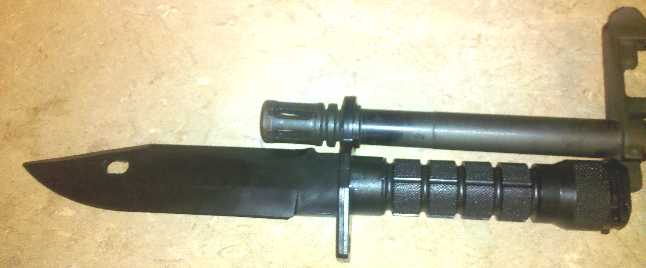

Available from AirSplat! for under $15, these should be purchased en masse by Army units so their Soldiers can shoot each other with MILES invisible lasers or SIRT Green visible lasers and if they should get close, combat each other with rifle-bayonet techniques as long as only the soft rubber/plastic blade is used for simulated stabbing/slashing. Butt strokes must not be used obviously since they will not be sufficiently padded. With flimsy M4 carbine telescoping stocks, there should be little temptation to use them anyway.
wolfarmouries.co.uk/airsoft/bb/product.asp?page=product&id=KG0011
A great non rigid bayonet prop. These are non-metal blunt prop knives which are great for pouch filling and for sites which allow melee skirmish rules (in game "knife" kills).
As with airsoft guns, these are visually convincing and should be stored, used and transported responsibly. Although they are flexible and designed for non lethal training use, improper use may result in injury.
Price: $12.49
Status: In stock
wolfarmouries.co.uk/airsoft/bb/gun.asp?page=postage
redwolfairsoft.com/redwolf/airsoft/ProductDetail?prodID=14922
Amazon
amazon.com/HFC-XM-177-Bayonet-Belt-Case/dp/B000FX304K
$9 from Airsplat
airsplat.com/Items/AC-UP-H203-BAYO.htm
(626) 539-3900 or
(626) 851-8111
M-F 9am-4pm PST

HFC M16 M4 Bayonet Airsoft Rifle
$8.99 per EACH QTY: Add to cart
Add to Wish ListItem Code:
AC-UP-H203-BAYO
Airsoft Guns Styles:
M16 AR Airsoft Rifle
Airsoft Manufacturers:
HFC (Ho Feng Corp)
In Stock: Yes
Model: Airsoft Gun Rifle Bayonet- HFC Plastic Bayonet for M15, M16, M4, or other rifles accepting of bayonet
- Very Realistic
- Great Aesthetic Appeal
- Perfect for Ultimate Realism on an Airsoft M4, M16, or G3
Introduction

The M9 Bayonet is a multi-purpose knife and bayonet officially adopted in 1984 by the United States. It is issued with a special sheath designed to double as a wire cutter.
As not many of you know and least of all care, February 19th was my birthday...
Thankfully, I'm not a Hobbit, which means I didn't have to give anyone gifts (and I can spare myself the hairy feet), but instead, my friends gave ME gifts. Among them, this beautiful bayonet courtesy of Forum Moderator and fellow teammate, Angel.
First Impressions

A week ago, Angel came to our usual Saturday game with something that raised a few eyebrows... specially mine. HE BROUGHT A KNIFE! Angel was the person who introduced me to airsoft in Greece. Furthermore, he's the most serious and dedicated member of our community, which added a lot more weight to my shock seeing him with such an item.
My first thought was... gosh, I had too many, I don't know where to start.... "it's not very wise to bring real weapons and why would him, being our spokesman, do such a dumb thing? did he go mad? what's wrong? is this a joke that I'm not getting? damn, that's a cool knife... "
Anyway, I finally came up with the guts to stop him cold and ask him something like "is that what I think it is?" and he grins and says, "sure buddy, take a look" and he pulls it out of the sheath and waves it around. My doubts had been confirmed, he was mad. Then I held it, and boy was I wrong... and in love... I realized it was a beautifully crafted replica of what looked like Rambo's favorite sidearm, and to my surprise... a gift to me.
Mounting Procedure

The back end of the grip comes with a clamp that attaches to M4 type rifles and any other rifles that use the same bayonet attachment system. Just insert the gun's barrel through the hoop on the knife's handle, push it in, and let the clamp lock into place. Very easy.
Construction

The HFC Bayonet is built with hard plastic and has an excellent metallic finish. I can't stress it enough, you won't know it's a toy until you touch it.
I read at wikipedia that the M9 design of the real steel version had some origins in designs for SEAL teams and the Rambo movies, believe it or not. The basic design was originally a commercial product (Buck 184), but it was developed into a model to compete in the new bayonet race. The design was later sold commercially as the Buck 188, but it was widely copied and sold by other makers. In 1986, Buckmasters patented the design and by doing so, they put many copycats out of business.
It is also worth it to mention the precise replication of the hole in the blade and the relevant insertion point in the sheath. Once the blade is attached to the sheath via these points the whole thing can act as a crude but rather effective wire cutter... At least the real-steel can...
Pricing Very fair... around $17.50 USD. BUT it's only 8.95
Review by Hellas Airsoft
Bayonets in the Personal Defense Zone (PDZ)
We need Soldiers that can THROW knives, also.
We explain this in detail in our web page below on Personal Defense Zone (PDZ) weaponry:
 youtube.com/watch?v=qDD3-w9FZMc
youtube.com/watch?v=qDD3-w9FZMc
Gil Hibben's Book on Knife Throwing @amazon.com
 amazon.com/Complete-Knife-Throwing-Guide-Hibben/dp/B0006Z08YM/ref=sr_1_8?ie=UTF8&qid=1331527913&sr=8-8"
amazon.com/Complete-Knife-Throwing-Guide-Hibben/dp/B0006Z08YM/ref=sr_1_8?ie=UTF8&qid=1331527913&sr=8-8"
MECHANDO FORCE STUCTURE & SIMBA TACTICS


The motorized U.S. Army in heavy ground pressure wheeled trucks stumbles out of these road-bound death traps with too much equipment on their backs is NOT sneaking up on any enemies with any stealth: we are getting constantly ambushed and being cashed $$$ and bleed out of Afghanistan. What we need to prevail in modern warfare are MECHanized COMMANDO or "MECHANDO" force structures where light tracked tanks and light infantry are combined to effect bold, cross-country maneuver avoiding HE land mines that can advance even in the face of enemy fires by armored mobility and wins by OVERMATCHING firepower--dominating the fight all the way from the individual Soldier PDZ all the way to Long-Range Battle (LRB):
 youtube.com/watch?v=CZ6sMy4y7xQ
youtube.com/watch?v=CZ6sMy4y7xQ
MECHANDOs also need to employ Stealth Infiltration Mechanized Bayonet Attacks (SIMBA) tactics like the WW2 British Commandos and U.S. Army Rangers used to sneak up on enemies and act as spearheads for larger forces. Study their WW2 successes and note the use of rifle-bayonets.

However, SIMBA tactics are not encouraged in our maneuver training centers like JRTC, since there is no safe way (yet) to train in hand-to-hand and rifle-bayonet fighting without injury, so the Soldier that gets the "drop" on the enemy under 25 meters yells "Close kill" and the Observer/Controller awards him the kill with the MILES "god gun". While we should develope a thick foam Nerf ball-type cover for the bayonet sheath so the Soldier can clunk another Soldier without injury in training or even an entire M9 Wire Cutter Bayonet rubber/nerf dummy blade that when it rubs on something it leaves a residue that an observer/controller can determine who was killed/injured etc. this will take time/money/effort that doesn't exist. AS rubber M9 WCBs are available now for safe FoF combats as long as the buttstock is not used--if we have weak M4 carbine plastic telescoping stocks there should be no temptation to use them, anyway.

There are no career-enhancing incentives (OER bullet statements, "atta-boys" from a job well done at JRTC etc.) for commanders to train our Soldiers to win the close fight. Short-term expediency focusing only on the upcoming METL tasks while ignoring the long-term combat skills of the Soldier as we waste time on sports PT, sexual harassment classes and cleaning the post. Because we ignore the close-range fight, things like RPGs can get shot at us en masse, resulting in us being stunned and bleeding. Because we ignore the close-range fight, things like gunshields on the ends of our weapons have yet to be developed. Because we are afraid of our men being real warriors, we don't teach them hand-to-hand combat in a REAL martial arts regimen because we are afraid of what they will do off-duty at bars/clubs. In war, we could pay for this Dixonian psychology of military incompetence timidity in our own blood.
Another weak point is all the Soldier Grenadier/Team Leaders with M16/M203 Grenade Launchers cannot attach bayonets using the existing lug because the 40mm grenade launcher barrel is in the way. Moreover, every Automatic Rifleman (AR) in the infantry squad cannot attach a bayonet to their M249 Light Machine Guns (LMGs). This means out of a 9-man squad, only 5 men in it can fix bayonets! It wouldn't be far from the truth to say; "Half the Army squad cannot even mount a bayonet charge". We can fix this.
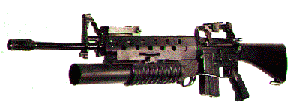


This can be solved by obtaining a Quality Parts/Bushmaster 1-(800) 998-SWAT add-on bayonet lug ($14.95 each) and turning it sideways so the bayonet is fixed SIDEWAYS on the rifle. Actually, this is the best position of the bayonet on a rifle since it can penetrate between the ribs of the enemy if he isn't wearing body armor. The add-on bayonet lug may even work as an add-on to the M249 Light Machine Gun (LMG), we will report back as soon as we determine this. The M249 LMG is NOT so heavy at 15 pounds that it can't be used with a bayonet to jab/attack an enemy. Its naive to think that its fickle belt of ammunition will always be there and working to fire after running and IMTing; consider how it failed SEAL Neil Roberts during the famous Takur Gar fight in Afghanistan.
Military historian/tactician Emery Nelson describes how to best get explosive effect muscle memory rifle-bayonet fighting capabilities:
 youtube.com/watch?v=mqtzqYYoCrQ
youtube.com/watch?v=mqtzqYYoCrQ
"To teach the bayonet, I would start out by working on the thrust. Have your Soldiers get in a split stance, dominant foot-hand back, weak foot-hand lightly forward, eighty percent of their weight on back foot. From that position, have them practice pushing off the back foot and stepping forward hard with the leading foot. I would have them do this 300 or 400 times, on command. Don't allow them to push forward with their bayonets. all this work should be done with the feet only. You're trying to develop a good solid base which has to happen below the waist.You want to give them time to recover the original position but this should also be work, with little time for rest. You must constantly stress explosion with the front step. You must explain to them that doing it right every time will allow the neural receptors to act at maximum speed, and if they do it different it will confuse the receptors and actually make them slow. One will help you win, and one will get you killed. Let them pick.
After you are sure you have enough reps to give them a good consistent base them they do the same with the thrust using only the arms, with the step already taken (in other words the feet should be in the position they will end up in). It would be best if they had a target to work from, perhaps something that is held by another Soldier. He should vary the height of the target but it shouldn't be moving (yet). After they work on exploding into the target with just their arms, several hundred times you are ready to get serious. It is important to make sure every Soldier 'earns the right' to go on to the full move. The full move should be done several hundred times again with explosion. If they can't do it with explosion for several hundred reps they move back to the beginning. after you are sure that they can perform the maneuver correctly you then turn it into brutal and competitive PT. After some easy jogging (half mile is good enough) you begin by having half of your men hold a target and the other assume the position I described in the beginning. To begin with they do ten thrusts just using the steps, no arms. Then the Soldier puts his feet shoulder width apart with hands and weapon extended over his head, hands also shoulder-width apart. The Soldier holding the target sets it down and puts his hands on the other Soldier's shoulders with his elbows locked. Soldier with weapon starts doing ten squat jumps while his partner provides resistance. The purpose is to develop explosive power. If done right this is a killer. You want to work up to a hundred jumps and one hundred steps without arm thrusts. Them go to arm-only thrusts. Repeat the same ten rep sequence only do ten pushups after ten thrusts. You can do different kinds of pushups like close grip, wide grip and dive bombers (killer). One hundred of these and most people will be quite 'stimulated'. Then you do one hundred full thrusts to finish. Over time I would add spice to the exercise by teaching the partner how to parry the thrust. Let them work in fear and fatigue, which is the way all infantrymen live anyway. You can figure out how to do butt strokes and other things using the same formula. The important thing to do is make them 'earn the right' to move on. You also want to move from the end of the move and work back to the beginning if possible, but you have to have a good base to start with.
A few words of caution. I have never done this particular drill myself until recently to perfect it. You may have to change it to suit the Soldiers but if you stick to the basic idea, I think you'll find it works. A big problem is teaching your leaders first. If you can sell them by teaching them to do it first you're home free. I would use it as a little different method of doing PT. Tell them that during a real bayonet charge, there would be a high level of fatigue and this is what you are trying to overcome. No sense getting there and not being able to thrust and butt stroke with authority. Repetition will overcome fatigue and the natural fear of having a bayonet charge performed on you. Reaction will take over during the really stressful times. Also try and make the target as much like a head and neck (throat) as possible.
On the question of taking the scabbard off, within reason it should always be off if possible. Nothing like cold steel on a hot morning. So much of the bayonet is psychological. The more you expose your Soldiers to the point, the less likely they will be to defecate in their pants at the site of one on the battlefield. In my mind the reason the bayonet should be taught has two purposes. One is two teach close combat assaults on enemy positions. The other is to withstand those very same assaults on from your enemies. It all goes back to Gen. Cota teaching those men how to assault a farm house in Normandy. Although Ambrose doesn't say this, those Soldiers would have been equally unable to defend a building. I try to think of everything as if I'm looking in a mirror. For offensive action you have defensive action. Physics exists in war, you have action and reaction, if there's not enough reaction to action you have the beginning of a vacuum. When we talk about collapsing the enemy from within this is what we mean. As you know, I don't like any attempt to put things into a formula, so just consider my last couple of sentences as a point of view not a commandment from heaven. The silhouette is a good idea, but some kind of dummy would be better but maybe impractical.
One last thing. How come we don't fire our weapons with the bayonet mounted? If we're going to 'train as we fight' then it should be considered. I picture a range where men use the bayonet in a live-fire close-combat course. Even mounting them on an indoor range would be a good training aid. Constantly telling troops to not use their bayonets under any circumstances is creating psychological resistance in the mind of the troops to using them in combat as well as in training. It's Gen. Cota's farmhouse, only worse because you've been institutionally forcing your Soldiers to not use them. We will pay in blood for this kind of thing. I noticed the British Infantry in DS doing everything with bayonets attached. Of course they had just had the Falklands as a guide. I'd bet good money that Force XXXI will use bayonets on their pulse lasers as it's been used since man made his first edged weapon."

BAYONET AS MULTI-FUNCTIONAL FIELD TOOL
Many units do not even issue out bayonets to their men out of fears of what they might do with them. This forces the Soldier to buy his own field knife, but he still has no rifle-bayonet capability. Or you have one guy constantly bombarded by requests to use his knife to open ammunition cases, resulting in a lot of milling about and noise when if every Soldier had the M9 Wire-Cutter Bayonet by his side that he is supposed to have, he could do the task in place.
The M9 Wire-Cutter Bayonet (M9 WCB) is an awesome battle tool.


The inspiration for our new bayonet to have a wire-cutter capability came to 1st Tactical Studies Group (Airborne) Director Mike Sparks as a young marine infantryman in 1983 after noticing the Russian AKM bayonet can cut wire using its scabbard.
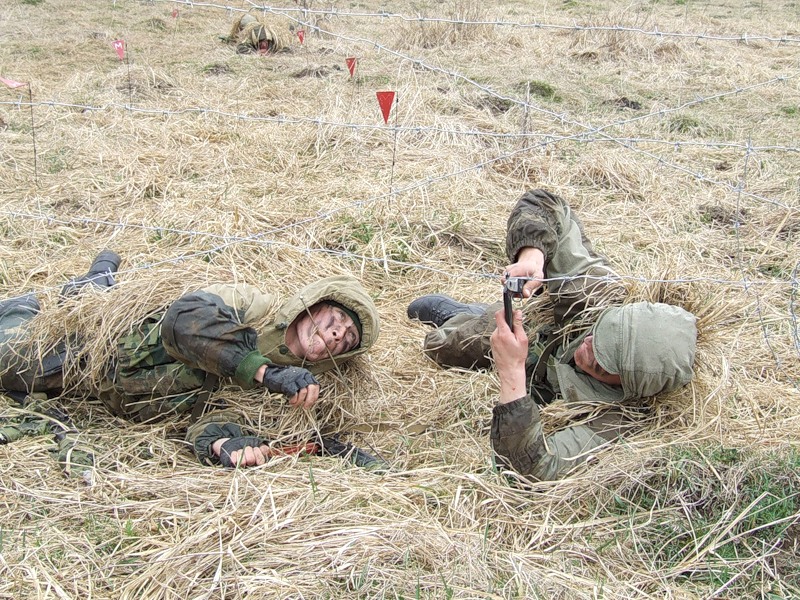
We found out later that U.S. Army Rangers used wire cutters extensively in WW2.
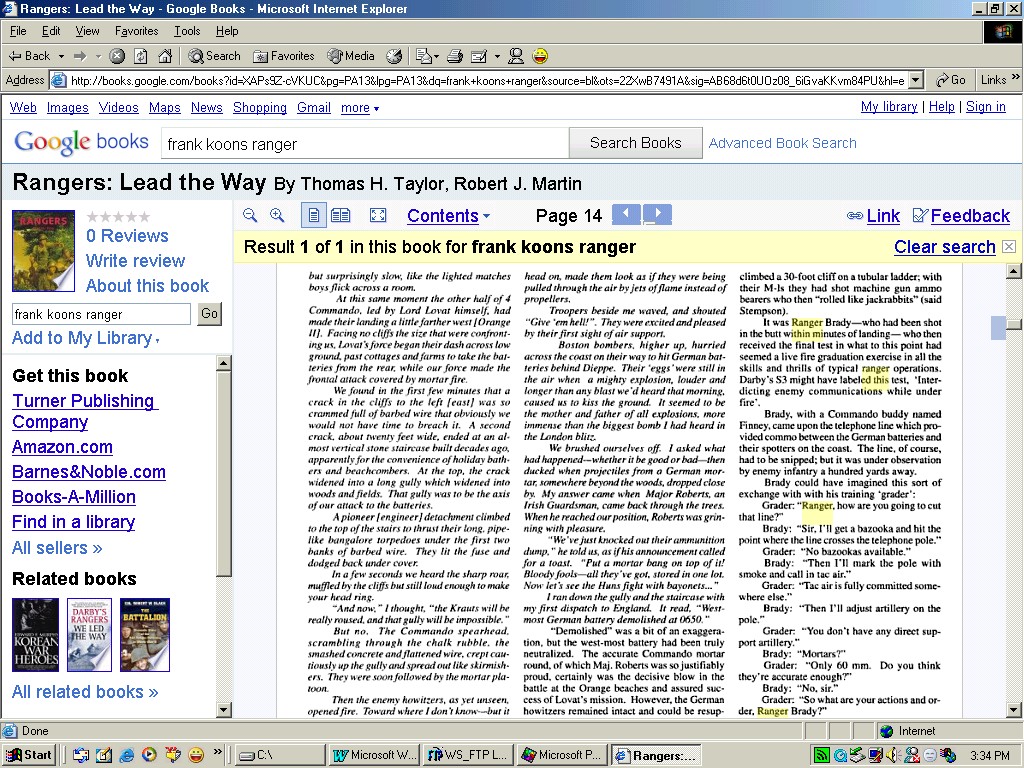

CPL Sparks sent this suggestion through internal USMC channels and this feature became adopted on the new M9 Wire Cutter Bayonet. The memo he received on this is below.

In 1989 Panama, American Paratroopers used its wire-cutting abilities to enter compounds and encircle and defeat enemies in buildings. In 1991 Desert Storm, units fixed bayonets before rooting out Iraqis hiding in trench lines. In 1993 Somalia, when Task Force Ranger's bullets ran low the bayonet was there as their last resort to fight their way to safety.

The M9 has a bottle opener, a screw driver tip, a pouch to hold a Multi-tool or a 9mm pistol magazine, a saw tooth edge for cutting tree limbs for camouflage, and/or constructing survival shelters. If there is only one tool that you take into the field, it should be a good KNIFE, yet we have hundreds of men in the field without them!

The M9 has a sharpening stone, yet most Soldiers do not even know how to sharpen a knife "correctly" (See one set of directions at bottom of this page) and many commanders deliberately kept the older M7 bayonets dull due to risk aversion. Most M7 bayonets, or for the matter MOST U.S. BAYONETS PERIOD have never even seen daylight from the arms room.
The point here is develop some "cajones" to fight the corrupt bureaucracy (U.S. Army VALUE of COURAGE---Comes from CONVICTION about the mission and the men, means ignoring the "me") and issue out your M9 WCBs to your Soldiers. If you can't trust them because you have psychological hang-ups about empowering others--(Read Dixon's On the Psychology of Military Incompetence), then that's a problem that needs to be addressed NOW--before they get live rounds in war. Find someone that knows how to sharpen and maintain them and spread the knowledge throughout the unit. Or get a small Fiskers sharpener tool and put it on your key chain or outside pouchette of your multi-tool (see FX video below).

 youtube.com/watch?v=8JwwnWOW0uw
youtube.com/watch?v=8JwwnWOW0uw
BAYONET BADGES? WE DON'T NEED NO STINKIN' BADGES (YES, WE DO)

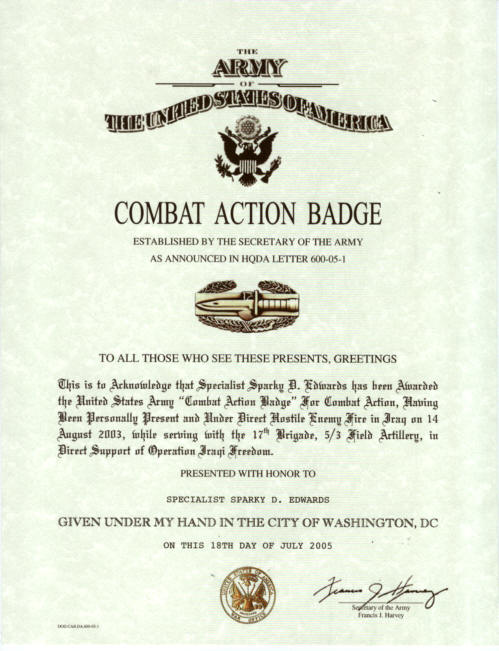
The good news is that the Army bureaucracy as an institution has imortalized the M9 WCB in it's Combat Action Badge (CAB) for non-infantry personnel to wear honoring their combat service. Ironic, huh? That the SYMBOL of the infantry--the bayonet has to be reminded of by non-infantry service. So, YES we damn well need BAYONET BADGES--so we don't forget WHAT RIGHT LOOKS LIKE.

Same applies to Combat Life Savers (CLSers), too--if the bureaucracy doesn't value something with a BADGE; it doesn't value it--and it will not be long before it's no longer funded or done. Take the nearly badgeless USMC--advanced skills are not valued at all--hence no advanced skills like the Army's Expert Infantry Badge (EIB) fosters--just sluggish line infantry that slams into problems. Witness our atrophy in CLS skills (IVs no longer required)--and our amnesia about the need for Rifle-Bayonet WarPrac. The simplest remedy is to DICTATE (that's right-use those blind obedience powers for military excellence for a change--instead of garrison BS) EVERY SOLDIER QUALIFY with the Rifle-Bayonet each year. To signify it he/she wears the BAYONET qualification bar under their marksmanship badge earned. Certainly for EIB, no bayonet qualification, no EIB.
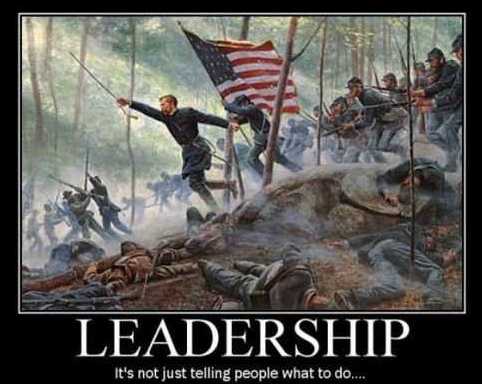

BETTER CLOSE FIGHT TTP

The bayonet needs to be fixed before attacking or entering a building/room/trenchline to clear it as standard Tactics, Techniques, Procedures (TTP). There is no guarantee that your grenades will have killed let alone stunned the enemy, nor that your shooting has hit and incapacitated him. You need to be ready to stab him and buttstroke him----one of the reasons I prefer the full-size M16 rifle over the M4 carbine is its ability to deliver buttstrokes in a close fight.
We need to raise rifle-bayonet fighting skills to a high level so we prevail in a close range fight by developing a tire house target range where the Soldier can charge a series of dummies and fire at them with live ammo, then stab/slash at them with the bayonet using the straight trigger finger to avoid an accidental discharge. This needs to be done at night with Night Vision Goggles, too.
"A chain is only as strong as its weakest link"--its time that the U.S. Army's close range fighting abilities with the bayonet are second to no one in the world.
AIRBORNE!

P.S. A tip for those with the older-model M9 WCBs with the Bianchi metal clip that gouges into your side (see blue circle in picture above). Take a pair of bolt cutters and cut off the end metal loops (where green arrow is pointing to)that are gouging into your side as they are unnecessary. You can press the metal clip higher up (where yellow arrow points to) and undo it, all you need is enough metal to snap into the clip itself.

Army Civilian "bean counters" remove sharpening stone from future M9 WCBs
Original M9 WCB had flap to cover the scabbard sharpening stone which you can see in the photos on this web page, which was removed on later production runs. Someone complained about the now exposed stone rubbing against her BDUs and now they want to remove the sharpening stone to "cut costs"! Afterall, noone knows how to sharpen knives, right? And sharp knives are DANGEROUS! Makes perfect logical sense to a civilian who will never face an enemy on the ground...but who needs more enemies? Now you can buy your own personal sharpening stone!
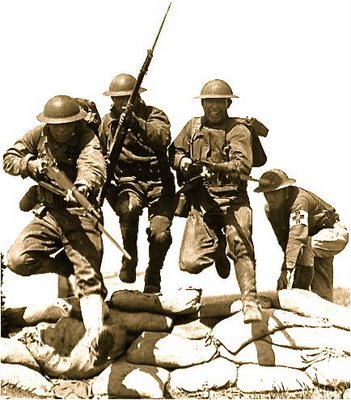
Now let's sharpen a knife and, in the process, dispel some myths. First, take two or three dollars to the hardware store and buy a standard little sharpening stone, probably the smallest available -- about 3 inches long, 7/8 of an inch wide and 3/8 of an inch thick. [Editor: you have such a stone on the back of your M9 WCB's scabbard until the Army civilians take it away from you] If you have a choice, go for "medium grit" and don't worry about whether it's natural or artificial stone. Later, when you've got decently sharp knives and want to push the envelope, you can seek out a special "fine" stone (to be used after the medium-grit stone.)
Not only do you not need to spend $467 for a knife set, you don't need to spend $1 for a can of 3-in-1 oil. You won't be using oil, because -- think about it -- you really don't want to reduce the friction between the stone and the blade. You want lots of friction, because that's what removes the extra steel on each side of the blade, leaving it with a thin, sharp edge. Articles on knife sharpening usually say that the oil keeps the stone from quickly "loading up" (that is, prevents its pores from getting clogged with steel dust). But even if you do use oil, the stone will load up, only more slowly...because the sharpening is proceeding more slowly. You want it to be quick, so forget the oil. Whenever the stone seems to have loaded up, just go to the sink, squirt some dish detergent on it, and wash it under the tap. Then go right back to sharpening; it doesn't make any difference whether the stone is dry or not.
You can cut yourself using my sharpening method, but not if you concentrate on the task. After some experience, the method becomes second nature. If you're right-handed, take the knife in your left hand, the edge of the blade turned away from you and its tip pointing to your right. Hold the stone in your right hand with the thumb at one end of its 3-inch length and the index finger at the other, your second finger helping to steady it. Now stroke to the right along the length of the blade, away from yourself. Most instructions call for stroking the blade along the stone. With a sharpening stone this size, it's easier to move it and hold the knife steady.

The angle is important. Aim for 10 to 12 degrees from the side of the blade. (With this approach, zero degrees would have the stone parallel to the blade, and metal from the whole side of the blade would be removed. And 90 degrees would have the stone at right angles to the blade, which would dull it up fast.) If there isn't a pro-tractor around, fold a sheet of paper in half diagonally to produce a 45- degree angle.Fold it in half again for a 22-degree and once more for an 11-degree angle -- the one you're aiming for. (This angle should be adjusted somewhat depending on the knife's task. For instance, a cleaver should be sharpened to a blunter edge; a knife for filleting fish to a sharper one.) By the way, the 22-degree wedge shows what a sharp blade looks like in cross section; that is, each side is angled 11 degrees from the blade's edge.
After a few strokes to the right, switch the knife so that the tip is now pointing to the left -- edge still away from you -- and stroke to the left on the other side of the blade. Keep switching back and forth, checking your progress as you go along. I feel the blade with my thumb, but that's a skill you can wait to pick up later. For now, if the blade catches on your fingernail rather than sliding over it, that's a good sign.
On large knives, one part of the blade will be sharp first. Just concentrate on the other parts and finish up with a couple of full-length strokes.
Notice that you are stroking the stone past the blade, so that the knife's edge doesn't dig into the stone. Most knife-sharpening advice calls for exactly the opposite motion, though both approaches sharpen equally well. Follow that other advice if you hate the sharpening stone and want to gouge it up fast.
When you've finished with the stone, often there will be a "feather edge" left -- loose metal which is attached here and there and which will get in the way of the keen edge. This can be remedied with a couple of strokes of a sharpening steel. However, I just use some fireplace kindling or the thigh part of my jeans. For obvious legal reasons, I recommend that you start with kindling. Draw the knife across the wood a couple of times as though you were going to saw through it at a 90° angle. You won't split off any wood or whittle away any shavings, you'll just get rid of the feather edge.
That's all there is to it!
hockscqc.com
CQB MagazineW. Hock Hochheim's THE HOCHHEIM GROUP
Less-Than-Lethal and Lethal Hand, Stick, Knife and Gun Close Quarter Combatives
FREE!!!!!! Receive a copy of David Hackworth's About Face absolutely free with any order of $50 or more! Just mention About Face in the memo section of your order. Going fast! Order now!
WORLD-WIDE TRAINING, CONSULTATION & PROBLEM-SOLVING
"Bridging the Gap between the Military, Police, Martial Artists and the Aware Citizenry."
New This April, 2004-
New: TRAINING MISSION FOUR DVD Set!
This 3-DVD set covers Level 4 in Hock's Hand, Stick, Knife and Gun CQC course. Only $69.95!
> New: the new 28" SDMS Combat Stick!
> New: Issue 1 of the Hochheim Group Report!
> New PAC Level 1 DVD
> New emails and articles!
Don't miss these remaining
CQC Group, 4-Day
Instructor Camps
-May in Germany
-September in Harvard, MA, USA
-September in Kansas City, USA
-November in Valdosta, GA, USA
-November in Australia
-December in South Africa
-All 2 day seminars build the CQCG too!More about Hock's Seminars
The HOCHHEIM GROUP is a worldwide organization that trains, educates and problem-solves citizen, security/enforcement/personal and group protection problems. This congress of specialists is geared toward researching and developing the best combat techniques, tactics and strategies and making them available to police, military, martial artists and the "aware citizenry" that will help them preserve life under extreme circumstances. These training courses are for regular people/citizens, police, guards, martial artists, and the armed forces. Contact us for consultations, professional protection and security teams and investigations world-wide.
"In our training courses, I teach martial courses, not martial arts. I consider myself more like a police academy instructor or a user-friendly drill sergeant, teaching hand, stick, knife and gun survival skills. It is about YOUR survival. It is all about YOU. All my research, experience, time and my qualifications are at your disposal when you train with me." --Hock
---------------------------------------------------------------------
Would you like to receive a notification of new products or upcoming seminars in your area?
If so, click [add me] and send us your name and address. If you would like to be taken off the mailing list, write LauricPres@aol.com
[Seminars] [Articles] [Biography] [Membership] [Endorsements]
[Books & Tapes] [FAQ eMail] [SDMS System]
[Hand-to-Hand Combatives] [Knife/Counter Knife Combatives]
[Archipelago Combatives - the Essence of Pacific Islands Combatives]
[Gun/Counter-Gun Combatives] [Congress Training Courses]
[Regional Instructors] [Close Quarter Combatives Group ] [The Training Room Talk Forum] [Home]
Lauric Enterprises, Inc.
P.O. 601, Keller, TX 76244 - (817) 581-4021 for questions or to order by phone.
W. Hock Hochheim can be reached by email at Hockhoch@aol.com
FEEDBACK!
An Army veteran writes:
"I like the Bayonet page. It's very simple, but I feel it can really have an effect on attitude. Do you think there is a chance of someone actually using it. My wife said it seems dangerous. I don't think it is, but old taboos (don't play with knives) can make people afraid of even the sight of a bayonet. That's what I want to overcome. If we can just make them unafraid of the bayonet and increase their own aggression in their initial contact, we win.
When I was in the Army I had a friend who was in the 1st Infantry Division. He had been a squad leader (shake and bake) from his first day in Vietnam. I asked him once if he had ever seen a bayonet charge. He responded, 'if they get that close we run!' I suspect it's that way for most of us. If you can use it, you can overcome it I think."
War Futurist Andy MacDougall writes:
"I've liked many of your ideas concerning bayonets, especially the one about attaching them horizontally for greater chance of rib cage penetration. One thing I'd like to add is that bayonets aught to attach from the bottom/cutting-edge end so in a scuffle a Soldier can PULL rather than push (arm is stronger in inward pull) the rifle in toward himself to cut the enemy, hopefully causing enough of a wound to make enemy recoil in pain and give Soldier enough space to reorient his weapon to stab the enemy proper with the bayonet. Since bi-handedness is so critical these days in combat (and me being left-handed I'm quite biased) the bayonet lugs should either be adjustable to face either side of the rifle or two sets of lugs should be used."
NEW! 1st Tactical Studies Group (Airborne) FACEBOOK Pages! UPDATES
> https://www.facebook.com/pages/1st-Tactical-Studies-Group-Airborne/137407686283499

